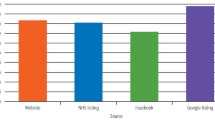Key Points
-
Focusing on those issues most important to patients encourages patient participation and therefore helps practices to receive good response rates.
-
Focusing the data on perceived outcomes around those issues supports efficient practice management.
-
By providing a benchmark based on responses received from other practices, dental teams are informed about their current perceived relative performance.
Abstract
Aim To develop a concise patient feedback audit instrument designed to inform practice development on those issues of greatest importance to patients.
Methods A literature review was used to establish the issues which were of greatest importance to patients. Ten core questions were then designed with the help of an experienced survey and polling organisation. A challenging grading of patient responses was utilised in an attempt to differentiate perceived performance within a practice on the different aspects and between practices. A feasibility study was conducted using the interactive voice response mode with seven volunteer practices in 2009. The instrument was then used in the later part of 2010 by 61 practices mostly in paper-based format. Practices received feedback which is primarily based on a bar chart plotting their percentage of top grades received against a national reference sample (NRS) compiled from the results of other participating practices. A statistical analysis was conducted to establish the level at which an individual practice result becomes statistically significant against the NRS.
Results The 61 participating practices each received an average of 121 responses (total 7,381 responses). Seventy-four percent of responses across all ten questions received the top grade, 'ideal'. Statistical analysis indicated that at the level of 121 responses, a score of around 4-9% difference to the National Reference Sample, depending on the specific question, was statistically significant.
Conclusion In keeping with international experience with dental patient feedback surveys this audit suggests high levels of patient satisfaction with their dental service. Nevertheless, by focusing results on the proportion of highest grades received, this instrument is capable of indicating when perceived performance falls significantly below the average. It can therefore inform practice development.
Similar content being viewed by others
Log in or create a free account to read this content
Gain free access to this article, as well as selected content from this journal and more on nature.com
or
References
Gladwell M. Blink. London: Penguin Books, 2005.
Goldman L, Caldera D L, Nussbaum S R et al. Multifactorial index of cardiac risk in noncardiac surgical procedures. N Engl J Med 1977; 297: 845–850.
Reilly B M, Evans A T . Impact of using prediction rules to make decisions. Ann Intern Med 2006; 144: 201–209.
Reichheld F. The ultimate question. Boston: Harvard Business School Publishing Corporation, 2006.
Newsome P. The patient centred dental practice. London: British Dental Association Books, 2001.
Gerbert B, Bleecker T, Saub E . Dentists and the patients who love them: professional and patient views of dentistry. J Am Dent Assoc 1994; 125: 265–272.
Howard-Williams P. Clinical audit and peer review scheme for the South West post-new 2006 dental contract: a report on progress so far. Br Dent J 2009; 206: 37–41.
Chisholm A, Askham J . What do you think of your doctor? A review of questionnaires for gathering patients' feedback on their doctor. Picker Institute Europe, 2006.
Busby M C. Measuring success in dental practice using patient feedback- a feasibility study Birmingham: University of Birmingham, 2011. M Phil Thesis.
Busby M C. The 'secret of success' part 1. Dent Update 2011; 38: 133–135.
Busby M C. The 'secret of success' part 2. Dent Update 2011; 38: 205–207.
Busby M C . The 'secret of success' part 3. Dent Update 2011; 38: 279–281.
Busby M C. The 'secret of success' part 4. Dent Update 2011; 38: 348–350.
Dillman D A, Smyth J D, Christian L M . Internet, mail and mixed-mode surveys. Hoboken, New Jersey: John Wiley & Sons Inc., 2009.
Eaton K (ed). Standards in dentistry. London: Faculty of General Dental Practice, 2006.
Electoral Reform Services. http://www.erbs.co.uk/.
Gilbert G H, Williams D, Rindal B et al. The creation and development of the dental practice-based research network. J Am Dent Assoc 2008; 139: 74–81.
Author information
Authors and Affiliations
Corresponding author
Additional information
Refereed Paper
Rights and permissions
About this article
Cite this article
Busby, M., Burke, F., Matthews, R. et al. The development of a concise questionnaire designed to measure perceived outcomes on the issues of greatest importance to patients. Br Dent J 212, E11 (2012). https://doi.org/10.1038/sj.bdj.2012.315
Accepted:
Published:
Issue date:
DOI: https://doi.org/10.1038/sj.bdj.2012.315
This article is cited by
-
Long-term validity and reliability of a patient survey instrument designed for general dental practice
British Dental Journal (2015)
-
Is any particular aspect of perceived quality associated with patients tending to promote a dental practice to their friends and colleagues?
British Dental Journal (2015)
-
Measuring oral health self perceptions as part of a concise patient survey
British Dental Journal (2012)



